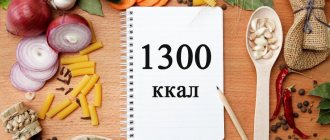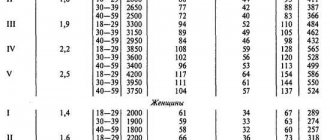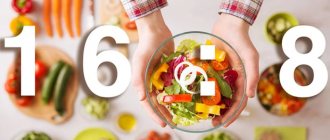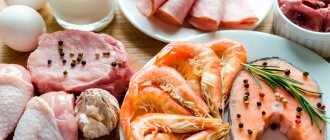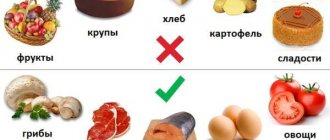Proper nutrition, weight gain or loss begins with diet correction; at this stage, daily caloric intake is also calculated. This indicator is different for each person; the daily caloric intake is determined based on personal data: height, body weight, age and physical activity. If you need to lose weight, then the daily norm is reduced, and if you need to increase muscle volume, then the caloric intake needs to be increased.
We offer you a menu for 1800 kcal with plans for each day of the week, calculations of KBZHU and detailed descriptions of dishes.
The essence and principles of the 1800 calorie diet
To function, the body needs energy, which it receives through food processing. If more energy substrates are supplied with food, then their excess is deposited in the form of subcutaneous fatty tissue.
When food calories are reduced, the body is forced to burn glycogen and fat reserves. The amount of energy used by the body depends on a person’s weight, height, gender, presence of chronic diseases, and lifestyle. But 1800 kcal is often enough for women to maintain weight or even get rid of extra pounds.
Calculation of caloric content and norms of BZHU
The calorie content of food is determined by the energy contained in nutrients: proteins, fats, carbohydrates. According to WHO experts, the average daily calorie intake should not be less than 2500 kilocalories (kcal).
Energy costs are calculated in calories. The total energy consumption during the day is summed up from:
- Energy consumption for basal metabolism is the minimum energy required for the functioning of vital organs at rest.
- Energy spent on any type of activity: physical and mental activity.
- Energy spent on digesting food.
Many formulas have been developed for calculating daily energy consumption. When calculating them, the following indicators are taken into account: weight, age, gender, level of physical activity, profession, climatic conditions and much more. Such complex “engineering” calculations are necessary in the practice of nutritionists, but in everyday life it is enough to master only a few simple techniques.
I – determination of calorie content of basal metabolism:
- For women: 0.9*weight (kg)*24=kcal/day.
- For men: 1*weight (kg)*24=kcal/day.
II – calculation of the daily calorie intake required for optimal physical and mental activity.
The basal metabolic rate is multiplied by the physical activity coefficient:
- sedentary lifestyle – 1.4;
- average physical activity – 1.75;
- heavy physical labor – 2.4 and above.
III – calculation of calories as a percentage of the main nutrients: proteins, fats, carbohydrates:
Women:
- proteins – 25%;
- fats – 25%;
- carbohydrates – 50%.
Men:
- proteins – 25%;
- fats – 15%;
- carbohydrates – 60%.
This ratio most fully corresponds to the energy, plastic and other needs of the body.
Example: how to calculate calories for a woman weighing 70 kg with average physical activity.
Basic metabolism: 0.9*70 (kg)*24=1512 kcal.
Average daily amount of calories: 1512*1.75=2545 kcal.
The next stage is to determine the optimal ratio of proteins, fats, carbohydrates in the daily diet:
Proteins: 2545*25:100=626 kcal.
Fats: 2545*25:100=626 kcal.
Carbohydrates: 2545*50:100=1272 kcal.
Thus, a woman needs 2545 kcal per day to satisfy the physiological needs of the body. Proteins and fats account for approximately 626 kcal each, and carbohydrates account for 1272 kcal.
In order to create your own diet, you can use special tables of caloric content of foods.
When the energy potential of the food consumed matches the body's needs, metabolic processes associated with the absorption of nutrients and the removal of toxic breakdown products work especially effectively.
Daily norms of carbohydrates, proteins, fats are average indicators that are for reference and informational purposes.
The nature of nutrition affects all biochemical and physiological processes in the body. A deficiency or excess of certain food ingredients triggers pathological processes, which leads to the development of diseases.
Therefore, it is so important that the diet maintains a balance of proteins, fats, carbohydrates, vitamins, minerals, and that the daily calorie content does not exceed the values recommended by nutritionists.
Rules for creating a diet
During the diet you need to follow simple rules:
- Eat in small portions, but 5-6 times a day (3 main meals and 2-3 snacks). This helps cope with hunger and speed up metabolism.
- Eat food at the same time. Gradually, the body will learn to receive and digest food on a schedule, and the feeling of hunger will arise only before a meal.
- Include predominantly protein foods in your diet (this will help increase muscle mass, make your body stronger and more resilient).
- Start your morning with a glass of warm water.
- Avoid fried foods. Products can be boiled, steamed or grilled, or baked.
During the diet, you must avoid fried foods.
Permitted and prohibited products
The following products should predominate in the daily menu:
- dietary meat (poultry fillet, beef, veal, rabbit);
- low-fat varieties of hard cheese;
- dairy and fermented milk products (fat content no more than 1.5%);
- porridge (oatmeal, rice, buckwheat, millet, corn);
- vegetables, raw or cooked;
- fruits (except sweet grapes);
- dark chocolate without sugar, natural honey.
You need to exclude the following products from the menu:
- baked goods made from white flour (including bread);
- fatty meats, fish and seafood;
- smoked meats;
- candies, sugar, sweets, ice cream;
- sausages;
- pickled foods and pickles;
- carbonated drinks, alcohol.
Alcohol is a product that should be avoided.
BJU ratio
A calorie deficit helps you lose weight.
But it is important that the body receives energy substrates and “building” substances in sufficient quantities. Therefore, it is necessary to calculate the ratio of BZHU daily, which must meet the following standards:
- fats - 15% (about 1.1 g of fat per 1 kg of human weight, sources of lipids should be plant products and fish);
- proteins - 30-35% (daily value - 2 g/kg);
- carbohydrates - 50-55% (preference is better given to complex, hard-to-digest sugars).
Energy distribution
When composing your diet, you should divide the calorie content of food in this way:
- breakfast - 380 kcal;
- lunch - 190 kcal;
- lunch - 580 kcal;
- afternoon snack - 220 kcal;
- dinner - 430 kcal.
Drinking regime
Drinking plenty of fluids is an important part of any diet.
Water accelerates metabolism, cleanses the body of waste and toxins, improves the functioning of the digestive tract and prevents constipation. You need to drink at least 1.5-2 liters of liquid per day. It is better if it is pure water without gas, but herbal infusions, unsweetened compotes, and green tea are suitable.
During the diet, you need to drink 1.5-2 liters of clean water per day.
Duration
1800 kcal is enough to support the normal functioning of the body (if we are talking about women). Therefore, the diet can be followed for 2-3 months without any threat to health. But the calorie content of the diet needs to be increased during intense physical activity.
Grocery list
Recommended Products:
- Meat without fat, preferably chicken, turkey;
- Fish and seafood;
- Eggs;
- Milk, fermented milk products, low-fat without sugar;
- Low-fat cheese, cottage cheese;
- Vegetables, excluding potatoes, carrots;
- Unsweetened fruits;
- Vegetable oil, preferably olive.
Products that should be strictly excluded:
- Alcohol;
- Sugar, sweets;
- Flour, baked goods;
- Salted, smoked;
- Potato;
- Sausage, all sausage products;
- Fast food;
- Sweet carbonated drinks.
You should drink up to 2 liters of clean drinking water without gas per day. Getting enough water is very important for losing weight. Water fills the stomach, reducing the feeling of hunger, dissolves toxins and helps remove them from the body. This has a beneficial effect on metabolism and, in general, on all body systems. Limit salt.
Varieties of menus for 1800 kilocalories
There are different versions of the 1800 calorie menu. Some programs are aimed not only at weight loss, but also at improving health.
DASH Diet
DASH is a dietary nutrition plan developed by American scientists.
It helps improve your figure, normalize blood glucose levels, restore vascular tone, and prevent the development of hypertension and heart disease. The daily diet should consist of:
- 8 servings of whole grains;
- 5 servings of vegetables;
- 3 servings of low-fat dairy products;
- 2 servings of lean meat.
You can include a delicious dessert in the menu 4-5 times a week. It is important to reduce salt intake - no more than 1 tsp. per day.
To lower cholesterol levels
This meal plan was created for women under 40 who lead a sedentary lifestyle. The diet includes limiting the daily amount of fat to 12 g. The menu should consist of proteins and complex carbohydrates. This diet is not suitable for men because... they need more energy and cholesterol levels differ between the sexes.
From Weight Watchers
The diet, developed by Weight Watchers, is suitable for women who lead a sedentary lifestyle. In the first week, the daily calorie content of food should be reduced to 1600 kcal, and then increased to 1800. This will ensure slow, healthy weight loss.
Diet from Weight Watchers.
You can eat 4 servings of grains and vegetables (raw, boiled, baked), 3 servings of lean meat and nuts per day. Sweets are allowed to be consumed no more than once a week.
Recommendations and contraindications
The diet is complete in terms of energy consumption for the average person. If the menu is compiled correctly, then the food is suitable even for the treatment of gastroenterological diseases, but only after consulting a doctor.
Even a pregnant woman needs 2000 calories per day. But usually a child in the womb requires increased nutrition and increased vitamin supplementation.
The recommendation of nutritionists is to eat healthy. After all, even if you eat fast food, it is possible to reach your daily norm, but this does not mean that fats and simple carbohydrates will not be deposited in fat cells.
Example of a daily menu for 1800 calories
1800 kcal per day is enough to not feel hungry. The main thing is to give up high-calorie unhealthy foods in favor of PP dishes.
Healthy breakfast
A morning meal should provide the body with energy for several hours.
For breakfast you can eat:
- 150 g buckwheat (cook in water);
- 100 chicken fillets (boil or bake in foil, pre-rubbed with spices);
- 200 grated boiled beet salad (dress with 1 tsp vegetable oil).
Full lunch
A daily meal might look like this:
- 250 g cabbage soup (lean, without meat and additives);
- 100 g durum wheat pasta;
- 100 g boiled pollock fillet;
- 180 g of Greek salad (cucumbers, tomatoes, feta, fresh herbs);
- 100 g boiled cauliflower.
Light dinner
Dinner should be light, so the menu can include:
- 200 g stewed cabbage with mushrooms;
- 150 g fruit salad.
For dinner you can eat 150 g of fruit salad.
Snacks and dessert
It is recommended to have 2-3 snacks. This will help cope with the feeling of hunger. For lunch or afternoon snack, you can drink a glass of kefir/Greek yogurt, eat unsweetened fruit or a handful of nuts.
Cottage cheese easily turns into a delicious PP dessert: you need to mix the curd mass, yogurt and fresh berries in a blender to get a sweet, airy treat.
Dish recipes
Salad with tuna
Boil and coarsely chop 2 eggs. Chop 1 bell pepper and 2 tomatoes. Tear a few lettuce leaves with your hands. Mash 180 g of canned tuna with a spoon. Mix everything and season with a little lemon juice and olive oil. Salt to taste.
Protein chicken salad
Boil 0.300 kg of chicken fillet until tender and place the cut pieces on a plate as the first layer. Grease with sour cream. Boil 5 chicken eggs and separate the whites. Grate it on a fine grater and place it in a second layer on a plate. Grease the layer with sour cream. Grate 100 g of cheese and place in a third layer. Decorate with greens.
Turkey breast in mustard sauce
Cut 1 kg turkey fillet into portions. Mix 40 ml apple cider vinegar, 185 g mustard, 20 g chili pepper, 20 g ground black pepper, 40 g salt, 40 g marjoram, 20 g garlic, 20 g curry. Coat the turkey pieces with this mixture, place everything in a sleeve and bake in the oven for 30 minutes.
Fish fillet baked with vegetables
Wash 1 kg of fresh fish fillet, dry with a paper towel, remove the skin. Then cut into portions, grate with ground black and allspice, place in a deep saucepan or bowl. Pour the juice of 1 lemon over the fish and marinate for 15-20 minutes. Cut 2 carrots, 2 onions into strips up to 7 mm, 2 bell peppers into cubes 10 mm by 10 mm. Place the fish on foil, squeeze the garlic onto it through a garlic press, then arrange the chopped vegetables and salted to taste. Wrap the foil in an envelope, after pouring a little olive oil into it. Place in the oven to bake for 20 minutes.
This is how salmon, mackerel, pollock, and other fish are prepared.
The diet gives excellent results, the weight does not return, if at the end you adhere to the same nutritional principles and do not abuse prohibited foods. Gradually add foods containing complex carbohydrates: cereals, legumes, grain bread. Those suffering from liver and kidney diseases should consult a doctor.
THESE ARTICLES WILL HELP YOU LOSE WEIGHT
Sample menu for a week for 1800 calories per day
It is better to prepare the menu in advance. If you know what you'll be eating on a given day, the temptation to eat a hamburger or candy bar will be less.
Monday
Example menu for Monday:
- morning: 2 tbsp. oatmeal with milk, 20 g prunes, 2 slices of bran bread with low-fat cheese;
- lunch: 1 banana, ½ tbsp. yogurt;
- afternoon: 200 ml chicken broth with noodles, 150 g rice, 150 g chicken breast;
- snack: 40 g walnuts or peanuts;
- evening: 150 g baked hake fillet, 200 g tomato salad, 150 g boiled potatoes.
Tuesday
A daily meal plan might look like this:
- breakfast: 200 g buckwheat porridge with 1 tsp. butter, rye bread, 20 g cheese;
- snack: 2 peaches, ½ tbsp. kefir;
- in the afternoon: 300 ml of lean borscht, 100 g of pork liver stewed with onions, 200 g of baked potatoes;
- snack: 30 g almonds, 200 g cottage cheese;
- dinner: 150 g chicken breast, 150 g seaweed salad.
Wednesday
Menu for Wednesday:
- in the morning: a sandwich of rye bread with cheese, 2 boiled eggs;
- lunch: 200 g of cucumber, onion and tomato salad;
- daily meal: 300 ml cabbage soup with potatoes, 100 g boiled beef, 100 g buckwheat porridge;
- afternoon snack: 30 g raw sunflower seeds, 1 tbsp. kefir;
- dinner: 80 g of boiled peas, 150 g of pollock baked in foil.
